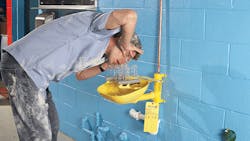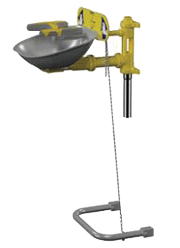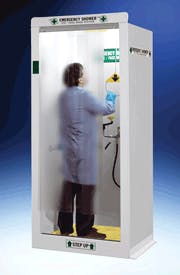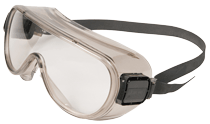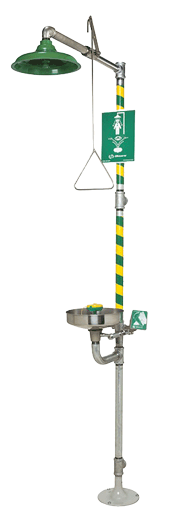Protecting Those Peepers: A Guide to Eye Wash and Emergency Shower Stations
Chocolate milk. That's what the water resembled to John Eliszewski as it flowed out of an emergency eyewash station.
While assessing eye wash and emergency showers for clients, Eliszewski, a Grainger technical safety specialist, says he periodically comes across companies that have failed to maintain the equipment. For an unsuspecting employee, this could mean the difference between losing his/her sight or experiencing severe burns after chemical exposure.
"These are designed to last a long time, and if they're maintained properly they'll be ready for that employee when he has that mishap and nobody knows when it's going to be," he says.
While OSHA's 29 CFR 1910.151(c) states where and when emergency eye wash and shower equipment must be available, it does not address specifics for the purchase, location or maintaining of stations. This is covered in ANSI/ISEA Z358.1-2014, which provides in-depth guidance for the minimum performance and use of this essential equipment.
Purchasing
When it comes to effectiveness, acquiring the most recent technology advancements not only make equipment easier for employees to use, newer designs provide more adequate water flow control, bodily coverage and compact design.
"Product manufacturers continuously are looking for new ways to enhance eye wash station shower technology, as well as systems for heating water commensurate with the ANSI Z358.1-2014 standard," says Ryan Pfund, senior product manager, Bradley Fixtures Corp.
ANSI specifies emergency shower spray patterns must have a minimum diameter of 20 in. at 60 in. above the work surface and a flow rate equal to 20 gallons per minute (GPM) for a minimum of 15 minutes at 30 lbs per square inch (PSI) for plumbed units. The flow rate should be equal to 20 GPM for a minimum of 15 minutes for self-contained units.
For eye wash stations, the fluid flow pattern should be no less than 33 in. but no greater than 53 in. from the work surface and deliver 0.4 GPM tepid flushing fluid for 15 minutes at 30 psi for plumbed and gravity-fed units.
The issue with some older shower designs is that water flow is pushed to the outer rim of the showerhead. This creates a hollow space in the center of the pattern that can miss affected areas, Pfund indicates.
New emergency shower designs incorporate fluid-dynamic technology and work in conjunction with a pressure-regulated flow control, making water spray patterns uniform and clearing contaminants from the user's eyes, face or body.
In addition, eye wash and shower stations have become more accessible as showerheads and stations are shrunk in size. This allows for less surface area in busy and cloistered industrial environments, making equipment easier to access, Pfund says.
Before purchasing stations or supplies, just as in any safety measure, a hazard assessment must be completed.
"You want to make sure you're sizing the equipment based on the exposure," Eliszewski recommends. "Have a hazard assessment done to identify where the stations are being used and dispensed and what type of hazards they are from a chemical standpoint. It needs to be an ongoing assessment that has to be done to make sure you're supplying the correct equipment."
Placement
The ANSI/ISEA Z358.1-2014 requirements for emergency station locations are the same for both eyewashes and showers. According to the standard, stations must be:
- Located in an area that requires no more than 10 seconds to reach Consult a medical professional to determine the appropriate distance for harsh acids and caustics.
- Located in a well-lit area and identified with a sign.
- Located on the same level as the hazard.
- Path of travel must be free of obstructions.
- If shut-off valves are installed in the supply line for maintenance purposes, provisions must be made to prevent unauthorized shut off
- The key to placement, once again, begins with the risk assessment. This will help determine how many stations you need to be compliant as well as identify any obstructions that could prevent an employee from reaching one. Despite being within 10 seconds away, doors, doorways and steps could spell trouble.
"Having obstacles in the way will just prolong treatment, and having chemicals in your eyes will impair your sight when you have to reach that station," Eliszewski says.
If there is no water or no plumbed water available in that location, products that contain their own source of water such as safety tank showers with the water tank located on top of the equipment may be applicable, says Mark Conron, president, FSI North America. (A list of different shower and eyewash station types is located in Example 1.)
However, self-contained water tanks must supply enough tepid water for 15-minutes of continuous use to be considered in compliance with ANSI standards.
Maintenance and Use
Weekly inspection and testing is crucial for effective use of emergency eye wash and shower stations. Without a regular maintenance schedule, the water required to safely rinse a worker's eyes or body should they have chemical exposure could become contaminated with particulates or chemicals (See example 2) or the equipment could fail to function properly.
"These inspections – that include activation – should be exercised and documented throughout a facility, to ensure all equipment is in working order, properly heated tepid water is available and lines are flushed," Pfund says.
Checklists are recommended for all equipment in order to make sure each unit works optimally. The amount of water and its quality cannot be stressed enough, not only because clean, sterile water is needed but also because temperature negatively could affect the worker after chemical exposure or affect shower operation.
If water is too cold, the employee might not be able to stand rinsing themselves for the required 15 minutes. He/she could even experience hypothermia, Eliszewski says. Heat is just the opposite. If the water provided above the required 60 to 100°F, this could even speed up a chemical reaction and subsequently cause more damage.
This is where placement works hand-in-hand with maintenance and use, and additional or specialized equipment might need to be purchased.
"Extreme wind or cold weather environments could make standard open air drench showers less than optimal and could lead to the need for heat-traced products in extreme cold weather and anti-scald or chiller-equipped products in extreme heat," Conron indicates.
Overall, there's no room for excuses when it comes to maintaining emergency stations, especially when it comes to fixing it.
"The beauty of a lot of the eyewash stations if that replacement parts are available," Eliszewski says. "All of manufacturers really do a good job of supporting replacement parts of eyewashes."
Lastly, under ANSI/ISEA Z358.1-2014 employees must receive training to attain an in-depth understanding of emergency showers.
"Training will allow for better safety purchases and a better level of protection for their employees because they're making the right choices. When they get the training, they make better informed decisions," Eliszewski says.
Example 1: What's your type?
Emergency shower and eye wash stations are available in different iterations depending on your needs and jobsite. Grainger breaks down the requirements outlined in ANSI/ISEA Z358.1, which narrows down how to select, install and maintain eye wash/emergency shower stations.
Emergency Shower
- Plumbed Shower: An emergency shower permanently connected to a continual source of potable water.
- Self-Contained Shower: A stand-alone shower that contains its own flushing fluid.
Eye Wash Stations
- Plumbed eye wash station: An eye wash unit permanently connected to a continual source of potable water.
- Gravity-fed (self-contained) eye wash station: A stand-alone eye wash device that contains its own flushing fluid that must be refilled or replaced after use.
Personal Eye Wash and Eye Saline
A personal eye wash is a supplementary eye wash that supports plumbed units, gravity-fed units or both by delivering immediate flushing fluid.
NOTE: Personal eye wash units do not meet the requirements of plumbed or self-contained eye wash equipment. Personal eye wash units can support plumbed or gravity-fed eye wash units, but cannot be a substitute.
Drench Hoses
A drench hose is a supplemental device consisting of a flexible hose connected to a flushing fluid that's used to irrigate and flush eyes, face and body areas.
Example 2: Improper Eyewash Use
The American Industrial Hygiene Association (AIHA) provides a list of real-life accounts in which chemical exposures caused serious injuries that could have been prevented with proper equipment, training, maintenance and use. Here is one example.
While using a fluorescent stain in the cytogenetics lab, I felt something splash up into my eye. I was not wearing safety goggles or glasses. I went to the nearest sink that had an eyewash (mounted into the counter with a handle and hose). I flushed-out my eye for a minute to remove whatever had splashed into it.
My eyes remained irritated; so, I flushed them out again at the eyewash station. Soon afterwards, my eyes began to swell shut. I walked over to the emergency room to be seen by the doctors. They were unable to pinpoint the cause, but thought I was having an allergic reaction to some irritant exposure to my eyes. I was given antihistamines and was OK after a few hours.
A few days later, I noticed someone using the same eyewash to clean glassware and stainless steel trays. The eyewash was draped over into the sink and sitting in a cleaning solution. So, the water from the eyewash that I was using to flush out my eyes was most likely contaminated with chemicals. This practice was discontinued immediately and the eyewash was cleaned and put onto a routine maintenance schedule that included regular flushes.
— Source: AIHA.org
